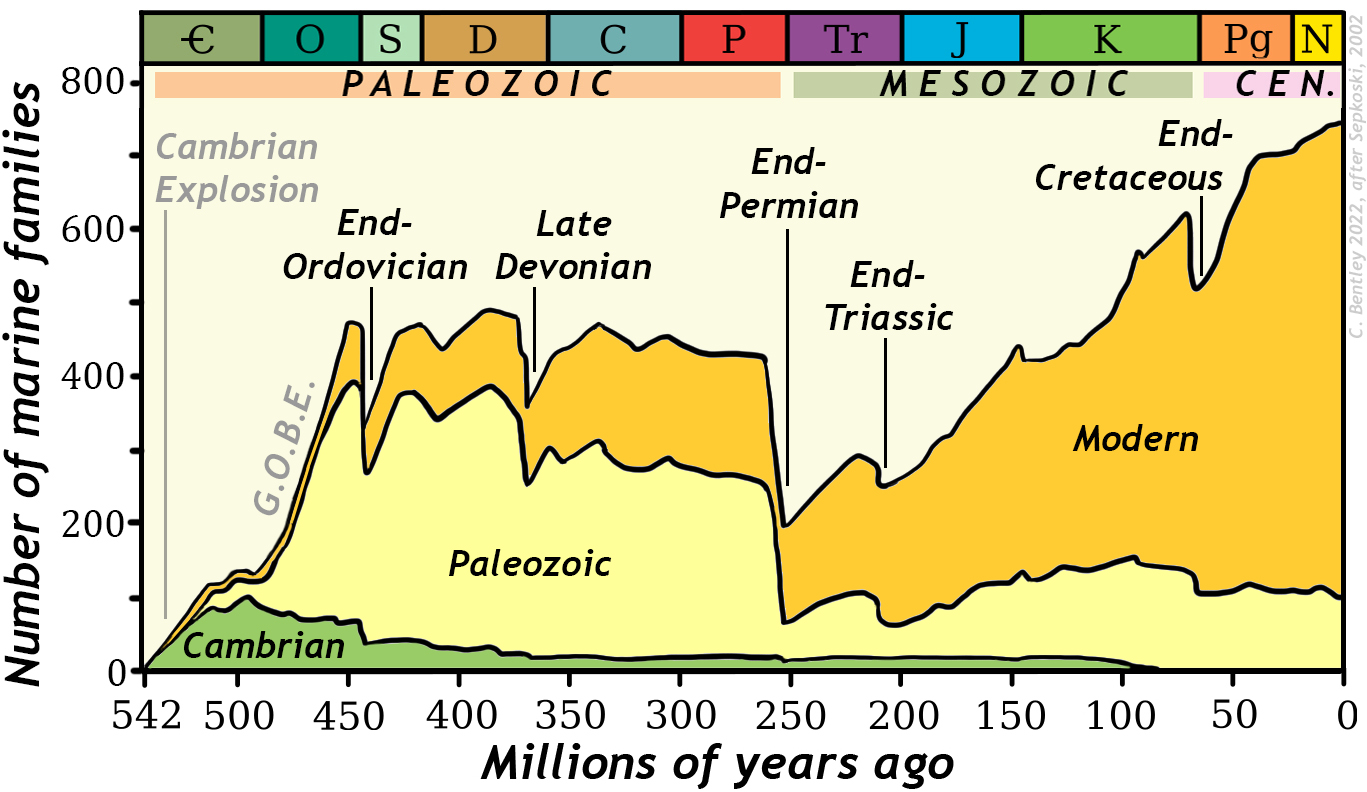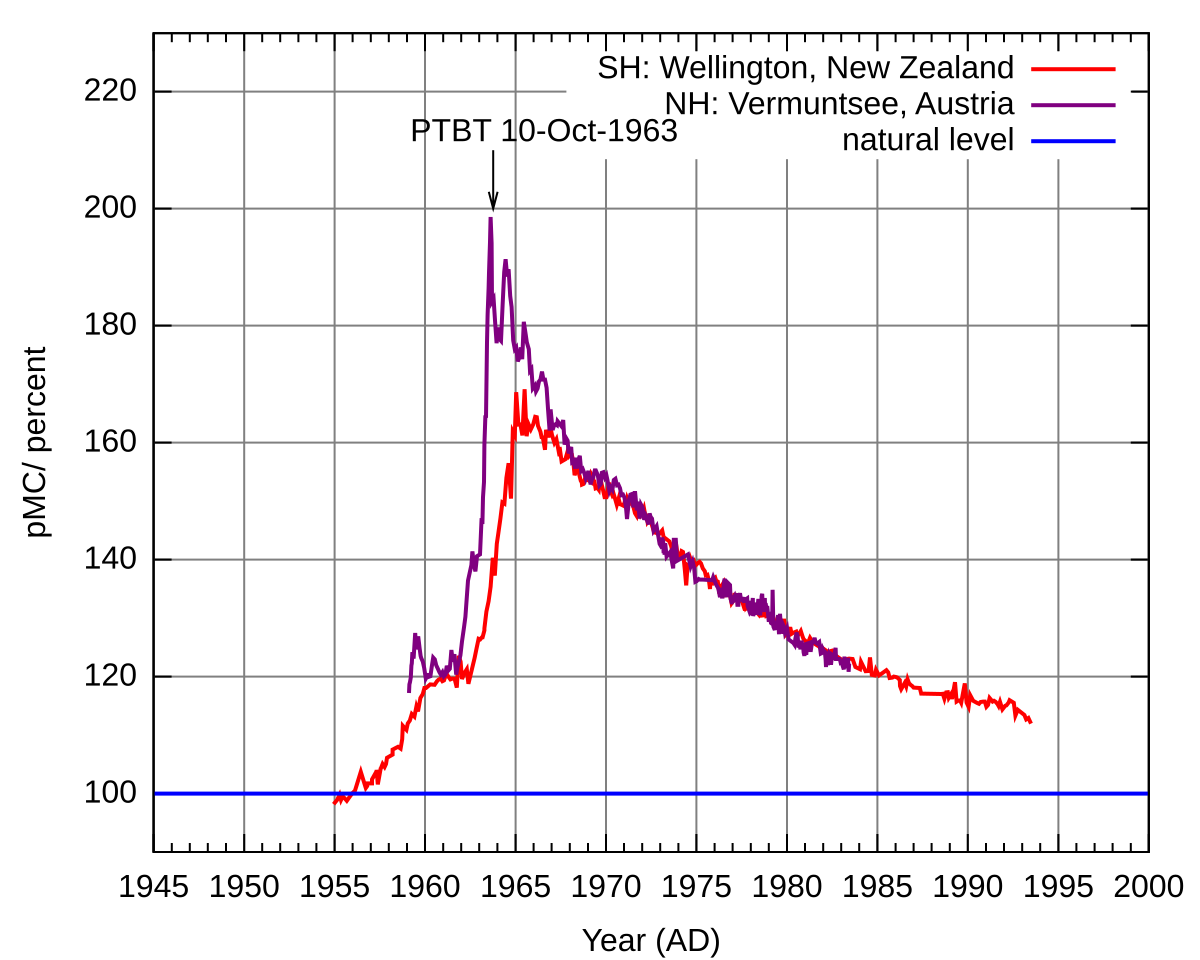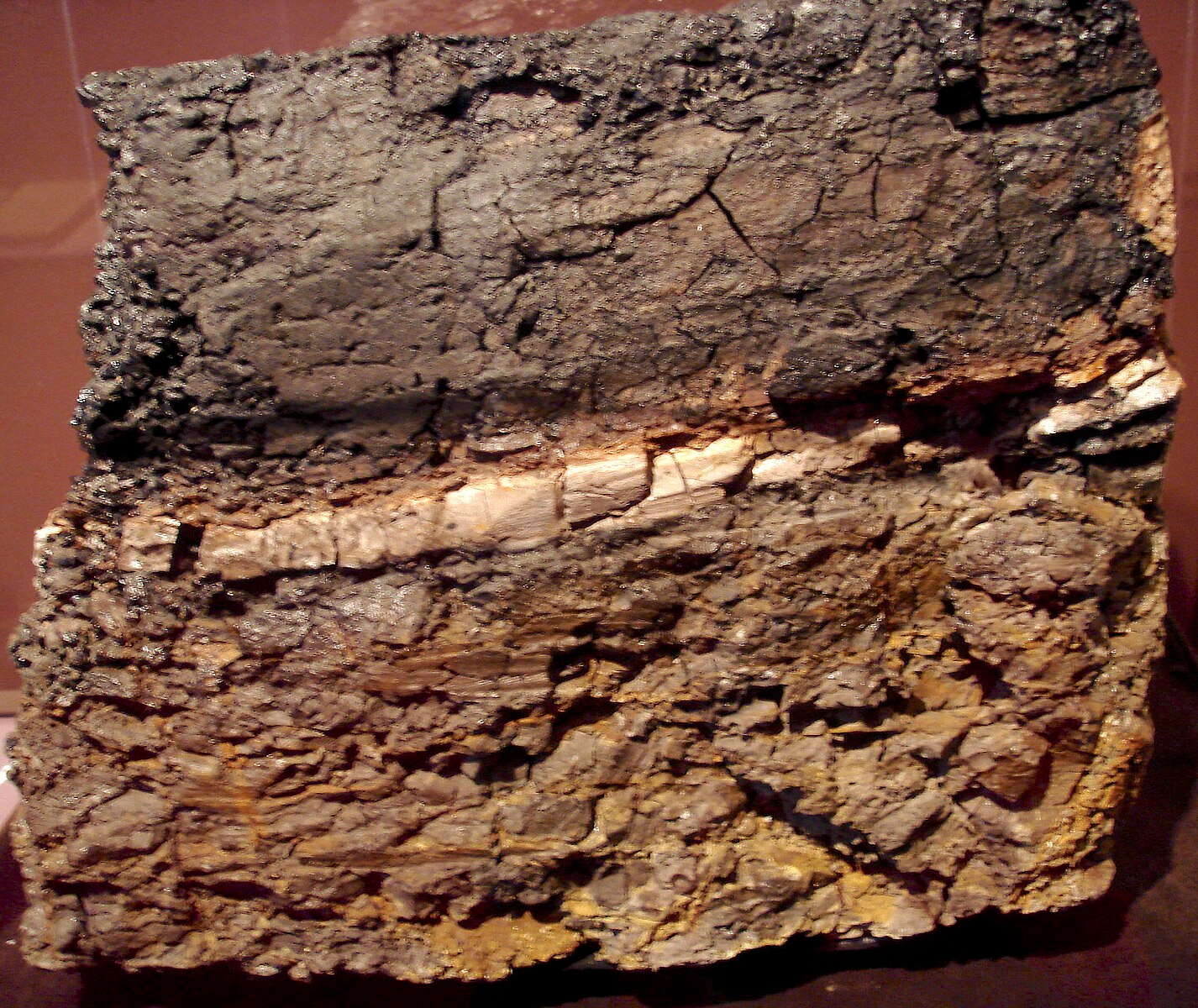IB Syllabus focus:
‘Five past mass extinctions had natural causes; today’s human-driven crisis may define a new epoch, the Anthropocene, evidenced by pollutants, species mixing, nuclear deposits, anthropogenic minerals and altered sedimentary systems.’

Labelled timeline showing marine animal family diversity through the Phanerozoic with the End-Ordovician, Late Devonian, End-Permian, End-Triassic and End-Cretaceous mass extinctions marked. The figure includes additional context (Cambrian Explosion, GOBE, era labels) beyond syllabus scope, which you may ignore if focusing solely on the Big Five. Source.

Graph of atmospheric radiocarbon (Δ14C) showing the sharp rise in the 1950s–early 1960s from above-ground nuclear testing, followed by decline after test-ban treaties. This globally synchronous bomb spike underpins the use of radionuclides as a stratigraphic marker for the proposed Anthropocene. Source.

Photograph of a hand specimen showing the thin, iridium-rich clay layer at the K–Pg boundary, the global stratigraphic signature of the asteroid impact that triggered one of the Big Five extinctions. This image illustrates how natural processes left clear markers in the rock record, offering contrast with Anthropocene signals. Source.
Earth’s history reveals cycles of extinction and renewal. Understanding past mass extinctions helps us interpret today’s biodiversity crisis and the potential definition of the Anthropocene epoch.
Mass Extinctions in Earth’s History
What are Mass Extinctions?
Mass extinction: A rapid, global loss of a large proportion of species across many ecosystems, caused by widespread natural disruptions.
Earth has experienced five major mass extinctions over the past 540 million years, each with distinct causes and consequences. These events fundamentally reshaped biodiversity.
The Five Major Extinctions
End-Ordovician (443 million years ago): Linked to glaciation and sea level fall, eliminating ~85% of marine species.
Late Devonian (359 million years ago): Possible causes include global cooling and ocean anoxia (low oxygen), wiping out ~75% of species.
End-Permian (252 million years ago): The largest extinction, with ~95% of species lost, likely caused by volcanic activity, methane release, and climate change.
End-Triassic (201 million years ago): Triggered by massive volcanism and rising CO₂, leading to ~80% species extinction.
End-Cretaceous (66 million years ago): Asteroid impact and volcanic activity caused the loss of non-avian dinosaurs and ~75% of all species.
Each extinction reset ecosystems, followed by adaptive radiations where surviving groups diversified into new ecological niches.
The Current Biodiversity Crisis
Human Influence on Extinction
Unlike earlier natural causes, today’s biodiversity crisis is human-driven. Key pressures include:
Habitat destruction through deforestation, agriculture, and urbanisation.
Climate change accelerating beyond species’ adaptive capacity.
Pollution contaminating land, air, and water.
Overexploitation from hunting, fishing, and resource extraction.
Species mixing through invasive species introduction and genetic homogenisation.
The extinction rate today is estimated to be 100–1,000 times higher than background levels, leading many scientists to call this the Sixth Mass Extinction.
The Anthropocene: A Proposed New Epoch
Anthropocene: A proposed geological epoch characterised by dominant human influence on Earth’s ecosystems, geology, and climate, leaving measurable evidence in the geological record.
The Holocene epoch (last 11,700 years) is being reconsidered as human activities now alter Earth’s systems on a planetary scale. The Anthropocene reflects this unprecedented influence.
Geological Markers of the Anthropocene
Geologists identify several indicators of human impact in sediments and rocks:
Pollutants: Plastics, heavy metals, and chemical residues embedded in soils and sediments.
Species mixing: Translocation of organisms through trade and travel, leading to invasive species and reduced genetic distinctiveness.
Nuclear deposits: Fallout from mid-20th-century nuclear testing provides a clear stratigraphic marker worldwide.
Anthropogenic minerals: Novel materials such as concrete, aluminium alloys, and plastics forming persistent geological layers.
Altered sedimentary systems: Large-scale land-use changes, dams, and agriculture reshaping erosion and deposition patterns.
These markers provide physical evidence that future geologists will distinguish from previous epochs.
Interconnections Between Mass Extinctions and the Anthropocene
Comparing Past and Present
While past extinctions arose from natural processes (asteroids, volcanism, glaciation), the Anthropocene crisis is unique:
Cause: Driven primarily by human actions.
Rate: Extinction occurring much faster than natural recovery rates.
Scale: Impact is global, affecting terrestrial, freshwater, and marine ecosystems simultaneously.
The Sixth Mass Extinction?
The debate centres on whether the Anthropocene should formally be defined as a new epoch and whether the current biodiversity crisis represents the sixth mass extinction. Key arguments include:
The current loss rivals past extinctions in scale but occurs within centuries, not millennia.
Human agency makes it distinct from natural mass extinctions.
Ecological impacts include collapsing food webs, reduced resilience, and permanent ecosystem transformation.
Importance for Biodiversity and Resilience
Ecological Consequences
Loss of ecosystem services such as pollination, water purification, and climate regulation.
Reduced genetic diversity decreases species’ capacity to adapt to environmental changes.
Disrupted resilience leads to greater vulnerability to disturbances, reinforcing ecological collapse.
Human Implications
Biodiversity underpins food security, medicine, and cultural identity.
Losses in the Anthropocene era directly threaten human survival and well-being.
Conserving biodiversity is not only ecological but also economic and ethical.
FAQ
Scientists compare current extinction rates to fossil records of background extinction. They use data on species range, population decline, and conservation status to model trends.
Modern tools include:
IUCN Red List assessments
Satellite monitoring of habitat change
Genetic studies showing loss of diversity
This combination allows estimation that current rates are far above natural levels.
Pollutants such as plastics, pesticides, and heavy metals are preserved in soils, sediments, and ice cores. These materials persist for centuries, leaving long-term chemical signatures.
Microplastics, for example, are now found in marine sediments globally. Their wide distribution ensures future stratigraphers can recognise the Anthropocene layer across continents.
Above-ground nuclear testing in the 1950s–60s spread isotopes like caesium-137 and plutonium worldwide. These isotopes entered soils, sediments, and even tree rings.
Because the fallout was globally synchronous and sharply defined in time, it provides a precise “time-stamp” visible across different environments.
Human trade, travel, and colonisation have moved species far beyond their natural ranges. This mixing has led to:
Invasive species outcompeting natives
Hybridisation reducing genetic distinctiveness
Homogenisation of ecosystems across continents
Such changes alter evolutionary pathways and biodiversity patterns, becoming a hallmark of the Anthropocene.
Humans have created materials unknown in natural geology, such as plastics, concrete, and aluminium alloys. These novel minerals accumulate in sediment layers.
Their persistence and global distribution mean they act as artificial “fossils,” helping distinguish Anthropocene strata from earlier epochs.
Practice Questions
Question 1 (2 marks)
Define the term Anthropocene and identify one piece of geological evidence that supports its recognition as a distinct epoch.
Mark scheme:
Definition of Anthropocene as a proposed epoch where humans are the dominant force shaping Earth’s systems and geology (1 mark).
Any valid piece of geological evidence such as plastics, nuclear fallout deposits, anthropogenic minerals, or altered sedimentary systems (1 mark).
Question 2 (5 marks)
Compare the causes of past mass extinctions with the drivers of the current biodiversity crisis.
Mark scheme:
Identification of natural causes of past extinctions (asteroid impacts, volcanism, glaciation, ocean anoxia, etc.) (1 mark).
Explanation that past causes were non-anthropogenic, arising from geological or climatic processes (1 mark).
Identification of human-driven causes today (habitat destruction, pollution, climate change, species mixing, overexploitation) (1 mark).
Explanation that current extinction rate is much higher than background rates, occurring within centuries not millennia (1 mark).
Explicit comparison showing contrast (e.g., natural vs. anthropogenic, slower vs. faster, different scale of impact) (1 mark).

